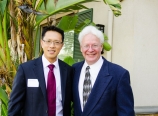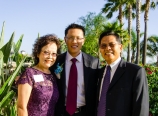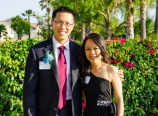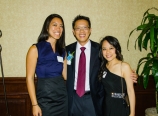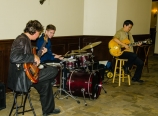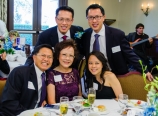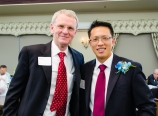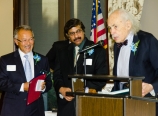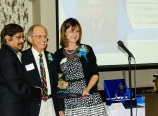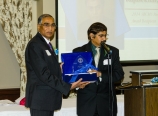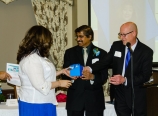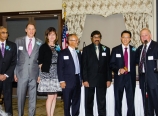
It was great to catch up with Dr. Ken Lane, who, along with Dr. Bangasser, introduced me to San Bernardino County Medical Society when I was a student. Tonight, I felt honored to be joined by my family, colleagues from Loma Linda University Health, and representatives from the medical community.
Tonight’s award recipients went to:
- Ronald P. Bangasser Medical Student Scholarship: Amity Tung
- Outstanding Contribution to the Medical Society Award: Leroy Ounanian
- Outstanding Contribution to the Community Award: Edwin Krick
- Outstanding Contribution to Medicine Award: Lawrence Longo
- Outstanding Citizen Award: Dee Dee Schilt
- Presidential Award: Damodara Rajasekhar
Lucy Garcia received special recognition for dedicating 35 years of service to the SBCMS.
Dr. Richard Thorp, California Medical Association President, installed the new slate of officers:
- President: Danny Wongworawat
- President-Elect: Marti Baum
- Vice President: Michael Sequeira
- Secretary: Eric Hansen
- Treasurer: Damodara Rajasekhar
- Immediate Past President: Raman Poola
For the remarks this evening, I highlighted how students and residents contribute to our society.
* * * * *
So, there were magical moments. There were magical moments for the medical students, for the residents, and for the rest of us doctors who were there. But most strangely, it was magical for our special guests.
It was the third Monday this past April, and all of us had taken time off from work and study. Landing in Sacramento earlier in the afternoon and having had time to unwind, we’re now at Lucca’s, once a regular dinner destination for Arnold Schwarzenegger.
We sit around several tables on the outdoor patio. Senator Jean Fuller, Norma Torres and her chief of staff, and Assemblywoman Cheryl Brown sit with our students; Senator Mike Morrell joins our table next to my two residents; and Assemblyman Curt Hagman sits next to me.
Dinner is served, and this is when the magic unfolds. Our students and residents transform into lobbyists right in front of our eyes. The residents paint a picture to illustrate why the 10% Medi-Cal cut needs to be repealed. The students tell stories of our country’s obesity crisis related to sugary drinks and urged for better warnings. Both the students and residents shared personal reasons why we should fund more residency slots.
These mini-speeches mesmerize our representatives, magically captured by the fact that these are mere students and residents who seem to wield words more effectively than seasoned lobbyists.
The next morning, at the Sacramento Sheraton ballroom, we hear a series of talks organized by CMA staff. As we all had expected, the underlying advocacy theme resonated in the preservation of MICRA.
MICRA—we all know what it is: the cap on malpractice awards for non-economic damages. What if MICRA wasn’t? Imagine an internist’s malpractice premium increasing ten-fold, from $3,500 to $35,000. Or, imagine Ob/Gyn malpractice premiums skyrocketing from $13,000 to $200,000. These aren’t exaggerations. We have these real comparisons between California and states without MICRA, such as New York and Florida. If a third of doctors’ salaries go to pay for malpractice, will there be doctors left here to care for Californians? For those of us who’ve only practiced in California after 1975, we have never experienced what a world without MICRA is like.
So at the Sheraton, the speaker looks at the students and residents and says, “If MICRA is gone, these students and residents, they may never know what it is like to practice under the provisions of MICRA.”
After the morning’s talks, we walk to the State Capitol, go through the security line, and make our way to the offices. The students had gone to their own session; so this time, it’s just residents and attendings. Our first stop is with Senator Bob Huff. Each resident takes on individual issues, but the theme is access for patients.
How many of us have patients that can’t get to see you in a timely manner? How many have some patients taking up 10-minute slots just for you to go over a simple test result? How much access would be freed up if you could just take care of these patients with simple phone calls and get paid for doing so? Well, AB 1771 does just that: telehealth reimbursement, for telephone and electronic management services. In our senator’s office, we urge support for this bill.
Now, how many of us know someone, or know of someone, who couldn’t get into residency because of the limited number of slots? With funding for residency slots held nearly constant while applicant numbers rise, this disparity has crossed into the crisis zone. Loma Linda University Medical Center, for instance, has residency funding capped at 1996 levels. So this morning, we’re standing in the State Capitol, our residents educating Senator Huff’s and Assemblyman Rodriguez’s offices on AB 2458, which would increase funding for residency slots.
Then, there’s AB 2458. In the Senator’s office, with all of us standing in white coats, my orthopaedic resident starts off about restoring the reimbursement lopped off by the 2011 10% Medi-Cal cut. He describes the patient access problems. Now, something magical happens. He trips up a little, then gets really tongue-tied, and then it spirals. I thought to myself, didn’t you rehearse this? Suddenly, he stops and, in front of everybody, says, “I’m so sorry. I’m just really nervous—really nervous because this means a lot to be standing here and explaining this, for us and our patients.”
Why is this magical? We don’t know where these bills will end up, but we got our representatives’ attention. Why do our representatives listen? Why do our patients listen? It’s because of authenticity. We’re not lobbyists; we’re just students, residents, practicing doctors, looking out for our patients.
Years ago, I was one of those students. It was magical when Dr. Ron Bangasser and Dr. Kenneth Lane mentored me and showed me how organized medicine is our most effective voice. San Bernardino County Medical Society and the CMA are our eyes, our ears, and our voice.
Of course, the issues were different then. Each year has its own issues. This past spring, we had a victory in Medicare’s geographic practice cost index fix, which increased Medicare reimbursement in San Bernardino County. This year, the MICRA fight is upon us. Who else to work this magic than all of us—students, residents, practicing doctors—all of us who have the privilege of caring for patients? We are the ones with the voice of authenticity to talk to our representatives, our patients, and the public.
As this evening draws to a close, let’s remember: we have this huge issue in front of us. Will we allow our students and our residents to never know what practicing under the provisions of MICRA is like? Organized medicine’s place has never been as important as now. Let’s take this challenge and strengthen our voice of authenticity.
I would like to thank you all for attending and making this evening special as I begin my term as President. Together, we’ll work this magic. Thank you, and good night.
* * * * *
Link to Alumni Association School of Medicine of Loma Linda University’s blog post




